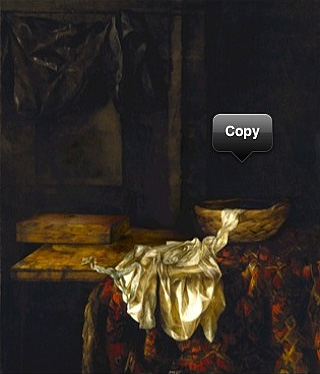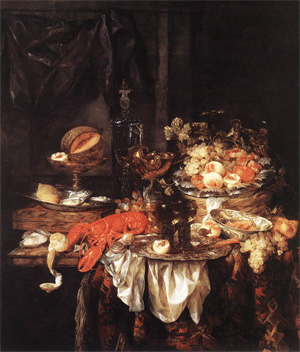 Artist John Baldessari has designed a curiously dopey iPhone app that allows a user to rearrange most of the objects in a 17th century still life painting called Banquet Still Life, by Abraham van Beyeren. Looking at this mess of a Dutch painting is like being beaten about the eyes with a hammer. But Baldessari is promoting his huge current retrospective, Pure Beauty, at the Los Angeles County Museum of Art. The show is extraordinary. If you are in L.A. between now and September 12, you should certainly go see it.
Artist John Baldessari has designed a curiously dopey iPhone app that allows a user to rearrange most of the objects in a 17th century still life painting called Banquet Still Life, by Abraham van Beyeren. Looking at this mess of a Dutch painting is like being beaten about the eyes with a hammer. But Baldessari is promoting his huge current retrospective, Pure Beauty, at the Los Angeles County Museum of Art. The show is extraordinary. If you are in L.A. between now and September 12, you should certainly go see it.
The app is called In Still Life 2001 – 2010.
This is the still life I came up with on my iPod Touch. I got rid of all the annoying little objects and just kept the good part of the painting. But my main question is, who painted in the parts of the background that are hidden in the original? Baldessari? That would be mildly amusing. Frankly, it would be more interesting than the app. Original missing parts of 17th century paintings by John Baldessari!
Here is the horrific original painting:

“Original horrific painting?” Where? The still life in question is expertly executed, well balanced, and filled with interesting things, some of which are symbolic. It’s exactly what a 17th century still life painting should be.
In the film, “Amadeus”, the Austrian emperor Josef II criticizes Mozart for writing an opera that has “too many notes”, adding that the human brain “isn’t capable of hearing more than a certain number of notes at the same time”. The same holds true apparently, for some art critics, who would think that an app capable of simplifying and weeding out the “extraneous” from Mozart’s music would be a good thing too.